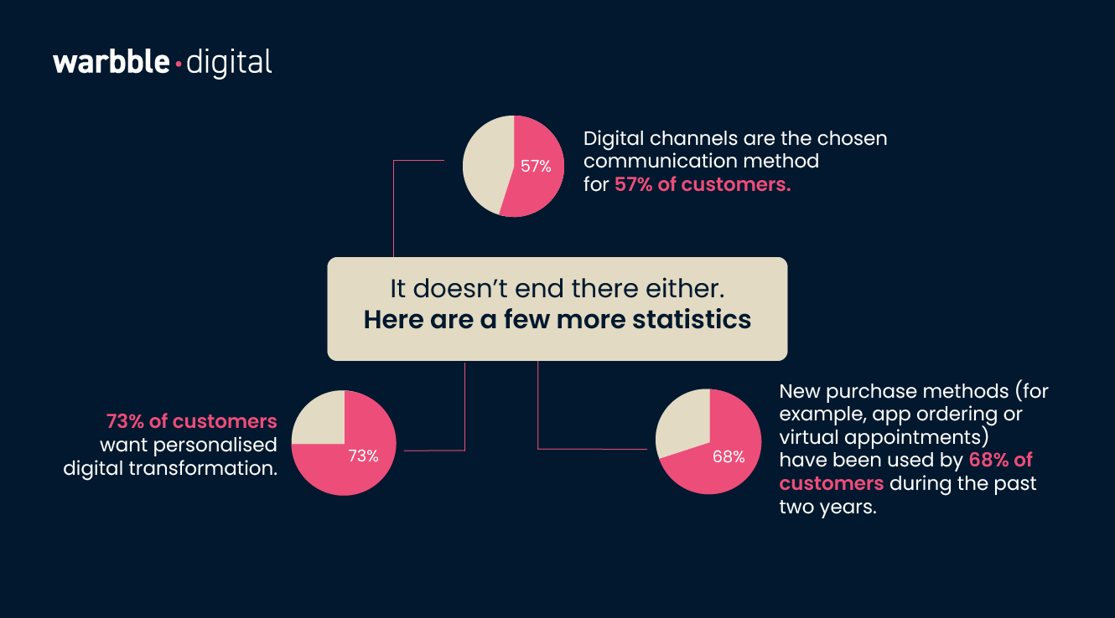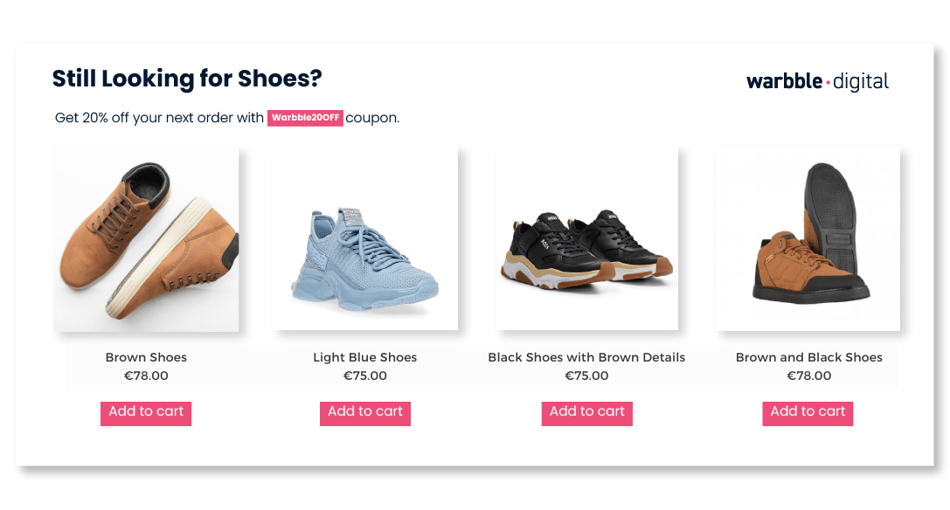Are you keeping up with the ever-increasing expectations of today's customers? In this digital age, businesses are witnessing a profound shift in customer behaviour, demanding a corresponding evolution in strategy. As the customer journey undergoes continuous transformation, it's crucial for businesses to adapt their approach to stay relevant and effectively connect with their target audience.
Consider this: When customers turn to the internet to research products and services, are you providing them with the relevant content and comprehensive product information they seek on your website and social media platforms? When customers need to contact you, are you utilising their preferred communication methods to engage with them effectively?
You need to adapt to these changing demands. If you don’t, you risk falling behind the competition. Using digital transformation is the solution, and allowing your customers’ needs to drive it, can make all the difference.
Customer Experience Builds Loyalty for 94% of Customers
The latest data supports the notion that digital transformation is an essential part of keeping customers happy. As a basis, 94% of customers who have an excellent experience with a company are more likely to make another purchase in the future.

There are many other statistics that support the idea that customer experience and digital transformation are intrinsically linked. The most important thing to take from these numbers is that personalised digital strategies will create highly engaged customers.
Consider the Customer Journey
Digital transformation has revolutionised the way customers interact with businesses, and you have to keep up. Understanding the customer journey is one way to help you in devising effective marketing strategies that can also permeate to other areas of your business.
Picture this: A customer starts their journey by researching products or services online. They stumble upon your website and social media channels. Now, imagine if your website provides comprehensive product information, engaging content, and a user-friendly interface. It becomes a seamless experience that caters to their needs. In contrast, a poorly optimised website or limited social media presence could drive potential customers away.
As customers progress through their digital journey, they may encounter pain points such as difficulties in finding relevant information, slow response times, or impersonal interactions. For instance, imagine a customer trying to reach out for support but facing delays or being redirected to generic FAQs. Such experiences can lead to frustration and prompt them to seek alternatives.
To address these pain points and cater to the evolving customer journey, businesses need to adapt their strategies. Implementing chatbots, for example, can offer instant assistance and personalised recommendations, enhancing the customer experience. Integrating social media platforms like Facebook, Twitter, or Instagram can facilitate real-time engagement and foster a sense of community. Leveraging customer relationship management (CRM) tools like HubSpot can help track customer interactions, enabling personalised and targeted marketing campaigns.
Platforms like WhatsApp have also gained popularity as convenient channels for customer interactions. Incorporating WhatsApp as a communication tool can foster a more personalised and responsive customer experience.
Embracing digital transformation not only enhances customer satisfaction but also positions your business as a forward-thinking and customer-centric brand.
Rethink Customer Interactions
Social selling and data-driven messaging can improve your customer interactions. Connect with your audience on a deeper level by adopting a personalised and relationship-based approach. Actively listen and engage in conversations that address their interests, pain points, and aspirations on social media to establish yourself as a trusted advisor, offering tailored solutions and valuable insights.
Another option is to utilise data-driven messaging to enhance your customer interactions. Analyse customer data to craft highly targeted messages that resonate with their preferences, behaviours, and purchase history, while also delivering personalised content, promotions, and recommendations to meet their specific needs.
One of the best options is to proactively engage customers through digital channels by anticipating their requirements and providing timely solutions.
For instance, imagine you operate an online store specialising in hiking gear. By analysing customers' browsing history and purchase patterns, you can send targeted emails or notifications featuring new hiking products, exclusive discounts, or upcoming hiking events in their area. This showcases your understanding of their interests and commitment to personalised experiences.
Something else to consider is how to streamline and scale your data-driven messaging efforts by leveraging automation tools and CRM systems. These resources help you efficiently manage customer interactions, track engagement metrics, and optimise messaging based on real-time insights.
By using social selling and data-driven messaging, you can foster stronger customer relationships. Engage actively with your audience on social media, offer valuable insights, and customise messages to suit their preferences and behaviours, but keep in mind that you may need to adapt your approach to meet the evolving needs of customers and to provide a seamless customer experience.
Adding Personalisation
One of our favourite sayings is “Talk to your customers, not at them”. It’s something small you can do that can have a big impact because it shows customers that you care about them.

Personalisation has become a vital component of successful customer engagement and by using various digital tools and strategies, you can create tailored experiences that resonate with their customers.
Let’s look at some ways to do this:
Use Customers’ Names and Purchase History
Digital platforms and CRM systems enable you to store and access customer information easily. You can integrate these tools and personalise your communication by addressing customers by their names.
Additionally, leveraging data from previous purchases allows you to provide tailored product recommendations and exclusive offers through automated email campaigns or personalised website content.
For example, if a specific customer always buys the same products monthly, you can send them a replenishment email to remind them to make a purchase.
Capturing Lead Details
Digital forms and interactive elements on your website provide an opportunity to capture lead details effectively which you can use for future interactions. By utilising CRM software, you can centralise and organise this information, allowing for personalised follow-ups and targeted marketing campaigns. This digital approach enables you to understand your leads' preferences and pain points and allows you to customise your interactions accordingly.
Product Recommendations
Your business has a bunch of knowledge based on previous purchases that you can use to your advantage. For example, you may know that customers who buy a certain product frequently find another product appealing. You can then use this knowledge with other customers for cross- and upselling.
Digital analytics tools, combined with machine learning algorithms, can also analyse customer data to generate accurate product recommendations. Consider implementing recommendation engines on your website or email campaigns so that you can personalise the customer experience by suggesting items based on customers’ browsing history, purchase patterns, and preferences.
Using Preferred Communication Channels
Digital channels such as email marketing platforms, social media, and customer support software offer a range of communication options. Allow customers to choose their preferred communication channels during sign-up or account creation to personalise interactions based on their preferences.
-
Ensure Data Privacy
Keeping customer data safe has become an important consideration for every business. There are many tools for data security and compliance management play that can help in protecting customer information.
Implementing robust data encryption, access controls, and secure servers safeguards sensitive customer data and ensures compliance with privacy regulations.
Communicate your commitment to data privacy through privacy policies and transparent consent mechanisms on your website to help build trust with customers and reinforce the value you place on their personal information.
-
Using Customer Feedback
Digital surveys, social listening tools, and online review platforms can help your business to collect and analyse customer feedback effectively. Digital feedback management platforms consolidate this feedback and give you an opportunity to make data-driven decisions, iterate on your personalisation strategies, and continually improve the customer experience.
Keep Customers Updated
The ability to keep customers informed and engaged can set you apart from other businesses. There are many different digital tools that enable efficient communication and save time through automation, which ultimately foster stronger customer relationships.
Order Tracking
Customers need to know what’s happening with their orders at all times, and communication is a big part of this. It strengthens customer relationships if you provide timely updates on new products, services, or important announcements. Regular communication also ensures that customers feel valued and engaged, leading to increased loyalty and repeat business.
Digital tools offer a multitude of ways to keep customers in the loop and ensure they receive timely updates. Email marketing platforms like Klaviyo, CRM systems, and social media management tools provide convenient channels for you to deliver relevant information directly to your customers.
Similarly, Wonderment is an order fulfilment platform that allows your business to manage orders proactively and sends communication to both the business and customers about any delays.
By utilising these tools, you can maintain consistent communication that keeps customers engaged and informed.
Using Automation
Automation is a game-changer when it comes to efficient customer communication. Through automated workflows and triggered campaigns, you can schedule and send targeted messages to a customer segment based on predefined criteria. Doing so eliminates the need for manual follow-ups and allows for seamless communication at scale with many people at once.
Additionally, efficient communication demonstrates a commitment to transparency and customer satisfaction. By promptly addressing customer concerns, providing order updates, or sharing relevant information, you build trust and credibility leading to long-term relationships and positive brand perception.
Digital transformation tools that facilitate efficient communication also save time and resources. You can automate repetitive tasks to streamline your communication processes, allowing you more time to focus on strategic initiatives.
For example, you can create a series of welcome emails that are sent automatically to people when they sign up to your website or newsletter.
Conclusion
Digital transformation has revolutionised customer experience by providing businesses with powerful tools and strategies to personalise interactions, streamline communication, and foster engagement.
While digital tools play a crucial role, it's important to remember that a human touch is still necessary. By combining the efficiency of digital transformation with authentic human connection, you can create meaningful customer experiences that leave a lasting impact on your customers which builds trust, loyalty, and long-term success.
Digital transformation is essential for business success!
Let us help you do it seamlessly.







